
HMS Furious was a modified Courageous-class battlecruiser built for the Royal Navy (RN) during the First World War. Designed to support the Baltic Project championed by the First Sea Lord, Lord Fisher, the ship was very lightly armoured and designed with a main battery of only two 18-inch guns. Furious was modified as an aircraft carrier while under construction. Her forward turret was removed and a flight deck was added in its place, such that aircraft had to manoeuvre around the superstructure to land. Later in the war, the ship had her rear turret removed and a second flight deck installed aft of the superstructure, but this was less than satisfactory due to air turbulence. Furious was briefly laid up after the war before she was reconstructed with a full-length flight deck in the early 1920s. Her half-sisters Courageous and Glorious were also rebuilt as aircraft carriers around that time.

816 Naval Air Squadron was a Fleet Air Arm (FAA) naval air squadron of the United Kingdom’s Royal Navy (RN) which formed at the start of the Second World War. It was first formed in March 1939, aboard the carrier HMS Furious, to support anti-submarine and strike missions for North Atlantic convoys. It conducted the first aerial torpedo attack of the war during the Norwegian Campaign in April 1940. An attack on the German battlecruiser Scharnhorst was attempted in September 1940, and on the squadron joined RAF Coastal Command in March 1941 for operations along the Dutch and French coasts. The squadron re-embarked on HMS Furious in June 1941 to provide anti-submarine cover while RAF aircraft were sent to Malta. On the return trip, it transferred to HMS Ark Royal and stayed with her until she sank in November 1941

800 Naval Air Squadron was a Royal Navy Fleet Air Arm carrier-based squadron formed on 3 April 1933 by amalgamating No's 402 and 404 Flights.

Royal Naval Air Station Hatston, was a military airfield located one mile to the north west of Kirkwall, on the island of Mainland, Orkney, Scotland, built as a Royal Naval Air Station. It was located near the strategically vital naval base of Scapa Flow, which for most of the twentieth century formed the main base of the ships of the Home Fleet. The airbase was designed to provide accommodation for disembarked Front-Line squadrons and accommodation for disembarked Ship's Flight Aircraft and was home to the Home Fleet Fleet Requirements Unit, 771 Naval Air Squadron.
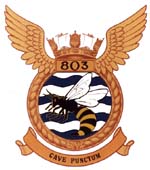
803 Naval Air Squadron was a Fleet Air Arm (FAA) naval air squadron of the United Kingdom's Royal Navy (RN). The squadron was operational on four occasions from 1933 to 1946, subsequently transitioning to a Royal Canadian Navy squadron from 1946 to 1951. It had an additional four separate periods of activity within the Royal Navy from 1951 to 1969.

701 Naval Air Squadron was a Fleet Air Arm (FAA) naval air squadron of the United Kingdom’s Royal Navy (RN), which last disbanded during September 1958 at RNAS Lee-on-Solent where it was a Helicopter Trials, Communications and Fleet Requirements Unit. It initially formed during July 1936 as a Catapult Flight operating out of Malta and routinely embarking in RN ships such as, HMS Barham, HMS Malaya, HMS Valiant and HMS Warspite. By autumn 1939 it was known as 701 Naval Air Squadron but disbanded in January 1940. It was active twice more during the Second World War, between May 1940 and June 1941 on special duties and then between October 1942 and August 1943 performing anti-submarine patrols. Reforming in April 1945 it was designated a Communications Unit, operating out of Heston until disbanding in 1947. It last reformed as a Fleet Requirements Unit at HMS Daedalus, Lee-on-Solent, during October 1957.
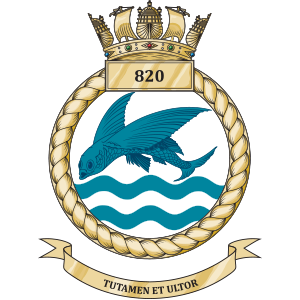
820 Naval Air Squadron is a Royal Navy Fleet Air Arm carrier-based squadron flying the AgustaWestland Merlin HM2 in Anti-Submarine and Airborne Early Warning (AEW) roles from RNAS Culdrose.
821 Naval Air Squadron was a Royal Navy Fleet Air Arm carrier based squadron formed on 3 April 1933 with the transferral and amalgamation of the Fairey III aircraft from 446 and half of 455 Flight Flights Royal Air Force to the newly formed Fleet Air Arm of the Royal Air Force. The squadron operated during the Second World War.
818 Naval Air Squadron was a Royal Navy Fleet Air Arm carrier-based squadron formed in August 1939. It served on a number of the Navy's aircraft carriers during the Second World War, serving in most of the theatres of the war, before decommissioning at the end of the war.
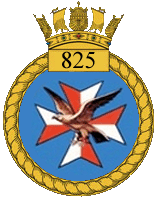
825 Naval Air Squadron is a Royal Navy Fleet Air Arm Naval Air Squadron which was re-commissioned on 10 October 2014 and currently flies the AgustaWestland Wildcat HMA2.
812 Naval Air Squadron was a Naval Air Squadron of the British Royal Navy's Fleet Air Arm. It was active between 1933 and 1956, and saw service in both World War II and the Korean War.

826 Naval Air Squadron was a Fleet Air Arm aircraft squadron formed during World War II which has been reformed several times since then until last disbanded in 1993.
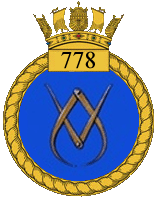
778 Naval Air Squadron was a Fleet Air Arm (FAA) naval air squadron of the United Kingdom’s Royal Navy (RN). During the Second World War the squadron was a Service Trials Unit (STU) initially based at HMS Daedalus, RNAS Lee-on-Solent, Hampshire, England before moving to HMS Condor, RNAS Arbroath, Angus, Scotland on 6 July 1940. The squadron tested all types of aircraft that could be used by the Royal Navy. Key to this was testing new types for deck landing on aircraft carriers. Such aircraft included various types of Supermarine Seafires, Grumman Hellcats, Grumman Martlets, Grumman Avengers, and Vought Corsairs. The squadron was reformed on 5 November 1951 with Douglas Skyraider AEW.1 but was disbanded on 7 July 1952 to form the basis of 849 Naval Air Squadron.
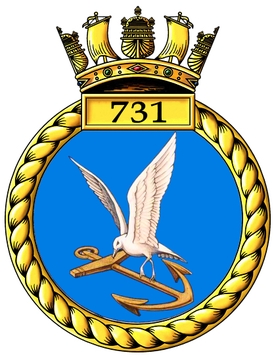
731 Naval Air Squadron was a Fleet Air Arm (FAA) naval air squadron of the United Kingdom’s Royal Navy (RN). It was active between 1943 and 1945 and its sole role throughout its formation was a Deck Landing Control Officer training squadron. Through this role the squadron pilots were nicknamed 'Clockwork Mice'. It was based out of the purpose built airbase, commissioned as HMS Peewit, known as Royal Naval Air Station East Haven, in Scotland, as part of the Deck Landing Training School there.

753 Naval Air Squadron was a Fleet Air Arm (FAA) naval air squadron of the United Kingdom’s Royal Navy (RN). It was active as an Observer Training Squadron from 1939 to 1946 as part of No. 2 Observer School, forming out of the School of Naval Co-operation RAF, in May 1939. Initially at RNAS Lee-on-Solent, the squadron moved to RNAS Arbroath just over one year later in August 1940, following a German bombing attack on the air station. It spent four years operating out of Arbroath, before relocating again, this time to RNAS Rattray, where the squadron disbanded in August 1946.

767 Naval Air Squadron was a Fleet Air Arm (FAA) naval air squadron of the United Kingdom’s Royal Navy (RN). It was initially formed as a Deck Landing Training Squadron in 1939, when 811 Naval Air Squadron was renumbered 767 Naval Air Squadron, at HMS Merlin, RNAS Donibristle. A detachment went to Hyeres de la Palyvestre in the south of France, enabling training in fairer conditions. While here, the squadron took on an operational mission, with a bombing attack on the Italian port of Genoa. With the fall of France the squadron evacuated to French Algeria, where it split. Part went to Malta, forming 830 Naval Air Squadron, the other part to HMS Ark Royal, with personnel returning to the UK via Gibraltar. The squadron regrouped at HMS Condor, RNAS Arbroath, and moved to the Deck Landing School at HMS Peewit at RNAS East Haven in 1943.

769 Naval Air Squadron was a Fleet Air Arm (FAA) naval air squadron of the United Kingdom’s Royal Navy (RN). It last disbanded and merged with 717 Naval Air Squadron after the Second World War. 769 Naval Air Squadron Formed at HMS Merlin, RNAS Donibristle, during May 1939, by renumbering 801 Naval Air Squadron. Its role was a fighter Deck Landing Training Squadron, using HMS Furious for advanced training, before disbanding in the December. It reformed in November 1941, as a unit within the Deck Landing Training School at HMS Condor, RNAS Arbroath, and in November 1943, it moved to HMS Peewit, RNAS East Haven. Its role changed to Torpedo Bomber Reconnaissance Training in 1944, before moving to HMS Merganser, RNAS Rattray, in July 1945.

774 Naval Air Squadron was a Fleet Air Arm (FAA) naval air squadron of the United Kingdom’s Royal Navy (RN) which last disbanded in August 1945. 774 Naval Air Squadron formed at HMS Kestrel, RNAS Worthy Down, in November 1939 as an Armament Training Squadron for Observers and TAGs. Aircraft were assigned from storage and a couple of other naval air squadrons. It moved a week later to RAF Aldergrove, and was attached to No.3 Bombing and Gunnery School. In July 1940 it moved to HMS Fieldfare, RNAS Evanton, and then in September to HMS Vulture, RNAS St Merryn, Throughout the next few years, the older aircraft were withdrawn and replaced with newer types and variants. 774 NAS moved to HMS Merganser, RNAS Rattray in October 1944, where it became a target-towing unit.

Royal Naval Air Station Twatt, is a former military airfield, located near Twatt, Orkney, Scotland, of the Royal Navy. It was built by the Admiralty and was commissioned on 1 April 1941. On 1 January 1942 it became an independent command as HMS Tern. The airbase was designed to provide accommodation for disembarked Front-Line squadrons and accommodation for disembarked Ship's Flight Aircraft and was home to the Home Fleet Fleet Requirements Unit, 771 Naval Air Squadron.
















